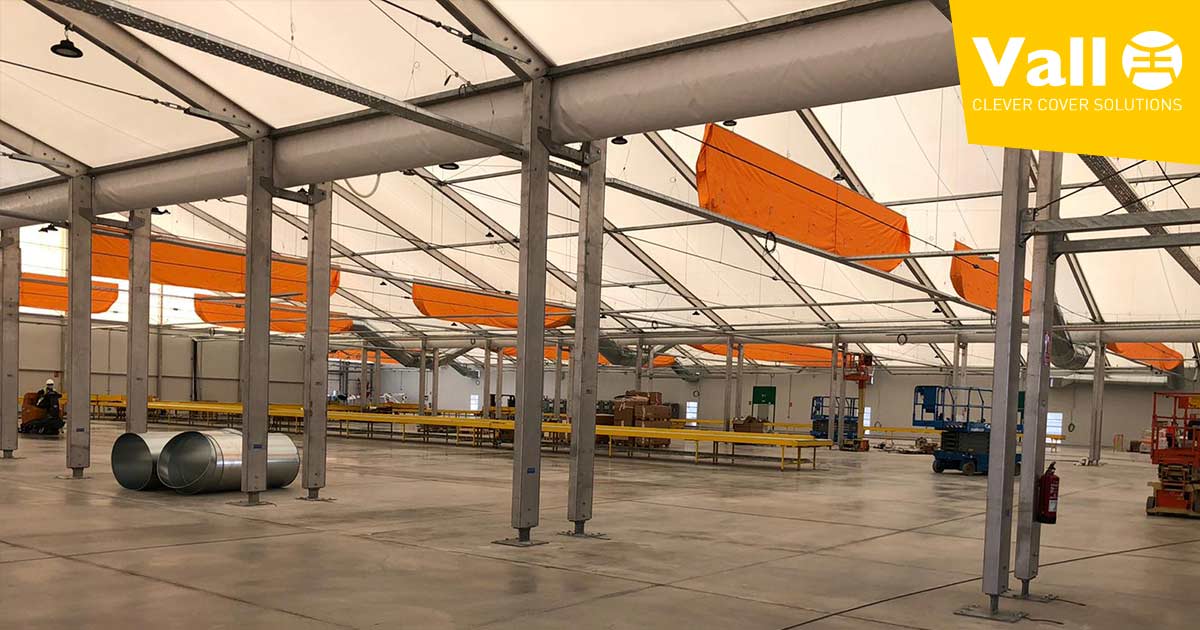Artificial intelligence and storage in industrial tents have a great future going hand in hand. In fact, in some cases it is already a relationship of the present. The potential of AI to improve logistics warehousing is brutal and there are already large companies that are taking relevant steps to make the most of this relationship.
Table of contents
AI is one of the trends in industrial logistics in 2024 that is already underway. But in reality, all types of logistics have in Artificial Intelligence a powerful ally for the future to optimise the performance of their warehouse.
AI enables advanced optimisation of logistics warehouses of any size, and contributes to improving their profitability. It allows companies to make significant monetary savings and improve their efficiency to be better considered by their customers and more competitive in the market.
At VALL we are manufacturers of industrial tents for logistics and we are always on the lookout for innovation in the sector to help our customers achieve their objectives.
Slotting optimisation with the help of Artificial Intelligence.
The design of the location of the products is key to the good performance of the warehouse. It is one of the key points for a good performance.
At VALL, we understand the importance of optimising stock management with an industrial storage tents. Combined with the possibility of optimising slotting with the help of AI, the improvement in terms of efficiency and space utilisation is impressive.
Artificial Intelligence draws on information from the past and makes predictions for the future. It is able to handle a huge amount of historical data. And so it proposes improvements in real time, for the current circumstances at any given moment, which allow the most efficient distribution in the logistics warehouse to be achieved, maximising the use of space.
Anticipatory logistics and better human resource management in the warehouse with AI prediction of consumption trends.
Another way in which artificial intelligence and warehousing in logistics come together in a productivity-enhancing tandem is in the field of anticipatory logistics.
AI launches reliable predictions based on real data obtained or processed by Big Data. For example, from sales history, social media trends, online product visits and queries, weather forecasts and other sources.
With these predictions, high-value decisions can be made in the warehouse to anticipate the consumption intentions of end buyers. Questions such as which goods should be kept in stock and which should not be stored in large quantities in order to optimise resources and avoid incidents.
Anticipatory logistics also enables valuable, cost-effective and efficient human resource decisions to be made. By anticipating labour needs at peak times and workloads, you can allocate the right warehouse shifts with the most efficient rotations. You can also avoid bottlenecks due to staff shortages and avoid unnecessary redundant positions.

Simpler and more reliable inventory management with AI.
From the above points it follows that another valuable relationship between artificial intelligence and warehousing in logistics is better inventory management. Combining the aforementioned AI predictions with optimal stock placement and reliable real-time monitoring of the warehouse operation and the goods in it makes inventory control much simpler and more reliable.
The improvement in the maintenance and management of inventories in real time is very relevant. So is the accurate tracking of orders at all times. And it improves the management of supply orders or immediate loading.
The precision and efficiency that artificial intelligence and warehousing in logistics allows is key to the profitability of companies.
Better resource allocation and productivity with automated logistics warehouses and Artificial Intelligence.
Robotics and management software have been part of modern logistics warehouses for some time now. To get the most out of this powerful investment by companies and optimise their resources, Artificial Intelligence is a valuable and powerful tool.
Robotic autonomy in the transport within the warehouse and the placement of goods is improved with the help of AI. This technology constantly generates and analyses the patterns followed by logistics warehousing automation systems. And it provides recommendations or orders to optimise resources in real time.
In addition, in the event of variations in the flow circuits of goods or transport within the warehouse, it can correct the movements to optimise these and the resources required to do so.
Coordinating automations: robotics and AI hand in hand in logistics warehousing.
All of the above is not the only thing that AI can do to improve productivity and efficiency in automated logistics warehouses. It is also a valuable technological tool for coordinating automations in the warehouse by designing the trajectories of autonomous vehicles and other processes that together significantly improve the company’s competitiveness.
AI simulations of logistics warehouse jobs for efficient use of resources.
The simulations provide key information to make decisions that help avoid delays and reduce costs. For example, calculating the time required for a job helps ensure efficient use of human resources with the right manpower to avoid understaffing that undermines tasks or overstaffing that unnecessarily increases costs.

Sources:
https://www.scmlogistica.es/inteligencia-artificial-en-el-sector-del-almacenamiento/
https://www.mecalux.es/blog/inteligencia-artificial-logistica








